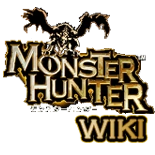|
In-Game Information
Amphibians with unique jaws and tusks that they use to sift through rocks for prey. They use their powerful hind legs to traverse steep terrain. The tail supports movement, but can become vulnerable with exertion.
Taxonomy
Order: Caudata - Suborder: Demon Frog - Family: Cabra
The Tetsucabra is a member of the Amphibian class and is a close relative of the Zamite and its adult form, Zamtrios. It was put into this class from it closely resembling amphibians like frogs and from it being different in many ways from other monster classes. Tetsucabra also has a closely related dark green Subspecies that it coexists with in the Sunken Hollow and Volcanic Hollow.
Habitat Range
In the Old World, Tetsucabra inhabit the Jurassic Frontier, Sunken Hollow, when the volcano is dormant in the area, and the Volcanic Hollow, when the volcano is active. Tetsucabra can also be found rarely in the Everwood, Desert and in the freezing waters of the Frozen Seaway. Within the New World they've been seen at the Deserted Island
Ecological Niche
Tetsucabra prey upon anything smaller than themselves that ventures too close to the water. This includes Kelbi, Aptonoth, Jaggi, Rhenoplos and Slagtoth. Due to their large size and tough armor, they have only other large predators to be wary of. These include Gore Magala, Deviljho, Glavenus, Najarala, Stygian Zinogre and Kushala Daora. They compete for territory with other aquatic inhabitants, such as Zamtrios and Tidal Najarala in the Frozen Seaway.
Biological Adaptations
The scales of a Tetsucabra is used mainly for camouflage inside caves and on them is a special oil that holds heat. Despite the look of the scales, its skin is actually flexible yet hard somewhat resembling an actual toad's skin. A Tetsucabra's skull is robust and durable enough to take a lot of damage from threats of all sorts. Though the Tetsucabra has two large tusks, these are not used for hunting. The primary function of these tusks is for defense and as means to manipulate the environment. The tusks themselves are capable weapons, but the Tetsucabra is also capable of hefting up heavy boulders. The Tetsucabra flings these boulders out of the way of its path but it can also use this as a method of attack to injure predator and prey alike. It uses these boulders as a shield against predators and hunters to prevent attacks. It also uses this to enclose small, tight areas, making it harder to maneuver. Another fact about the Tetsucabra is its ability to spit a glob of fluid at prey items. This sticky material acts as a powerful adhesive, sticking to the body and ground like glue. Even for a hunter, the adhesive quality of this material is not very strong, but it makes every movement a labor and greatly weakens the prey, leading to a reduction in stamina. When the Tetsucabra exerts itself, its tail inflates, possibly to help it balance itself as it picks up large boulders and rocks. The legs of a Tetsucabra help it perform powerful leaps, lunges, and jumps in the air to help it either ambush prey or to reach steep slopes out of its reach. A Tetsucabra's claws are powerful enough to break rock with ease and can destroy powerful armor.
Behavior
Tetsucabra are highly aggressive, territorial monsters though their ecology is much like a frog. The amphibians are well-known for attacking and eating anything that moves in their line of sight and leaping from ponds in order to grab potential prey. Despite being found in ponds, they spend most of their time on land, which could suggest that they patrol their territory on land, much like Zamtrios. During the breeding season male Tetsucabra will create large holes to impress females so that they'll lay their eggs in them. When the female lays her eggs in the pit the male will quickly fertilize them. After fertilizing the eggs the male will then carry them in his mouth and he will not eat anything until the offspring are fully developed.
